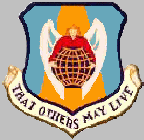
Home
FACs
More About FACs
The AO
Hué
A Shau Valley
Tet 1968
The Missions
Visual Recon
Close Air Support
Interdiction
Ranch Hand
Arc Light
SAR
Hammer 51 Rescue
Search for Jolly 23
• Search Rejoined
• Link to Past
Legacies
Aircraft
O-2A
Glossary
Resources
Contact
|

The Search for Jolly Green 23
A Link to the Past
| |
Bob Baldwin's posting to the FACNET message board
hit me like a thunder clap.
The memory of the loss of Jolly Green 23 had haunted me for
some time after my return from Vietnam, but to see a reference to
this tragedy 33 years after the fact was stunning.
After reading the message several times, I started rummaging through
a file cabinet in search of a document I had not looked at in over 25
years.
I found it in the back of the bottom drawer: my masters thesis in
aeronautical engineering written in the spring of 1971.
Opening it, I fumbled through the first few sheets to a dedication
page I had rewritten many times in my head during the two years after I had left Vietnam:
|
|

| |
Scanned page from An Investigation of the Performance of a Rotor in Vertical Autorotation, (Princeton, NJ: Department of Aerospace and Mechanical Sciences, Princeton University, May 1971, page iii)
|
|
| |
This was my link to four fellow airmen who died so tragically many years ago.
A few words in an insignificant technical document were my small attempt to perpetuate their memory.
In the days following the loss of Jolly Green 23, I was
haunted by Bob Dubois' description of the incident.
His words, " ... the main rotor stopped ... , " ran through my mind, and
I kept wondering what could have caused that to happen.
Why would the rotor just seem to stop turning?
Conversations with some of the Army helicopter pilots assigned to
MACV Team 3 at Hué introduced me to the phenomenon of
autorotation.
I learned that a helicopter can "glide" after the loss of engine power.
Just as a fixed-wing aircraft glides by exchanging potential energy
(altitude) to overcome drag and maintain flying speed, a helicopter
can use its altitude and airspeed to keep the rotational energy (RPM)
of the rotor high enough to maintain flight.
I also learned that under certain conditions it was possible for the rotor to rapidly decelerate and lose lift during autorotation.
Click here for a more technical description of autorotation.
Was this what happened to Jolly Green 23?
I realized that I likely would never know, but my left-brain
curiosity would not let it go.
I wanted to learn more about helicopter aerodynamics and autorotation.
Through an incredible stroke of luck, I was to get that chance.
In early 1969 I learned that my application to teach aeronautics at my alma mater, the United States Air Force
Academy, had been approved.
To prepare for this, my immediate follow-on assignment from Vietnam
was to graduate school in aero engineering at the Air Force Institute
of Technology (AFIT) at Wright-Patterson AFB in Ohio.
Since I already had one GI degree, I wanted to see what a civilian institution was like and asked the personnel officer at the Academy's Department of Aeronautics if I could specialize in vertical/short takeoff and landing (V/STOL) technology.
This apparently fit a need they had, so he requested that AFIT send me to Princeton University instead.
AFIT agreed, and in June 1969 I reported to Princeton to begin my studies.
While at Princeton I was privileged to work with some great people.
Dr. David Hazen, the associate chairman of the Department of Aerospace and Mechanical Sciences, was a friend of the military, and during some turbulent times on campus was able to guide and encourage me in my interest in helicopters.
Dr. W. Z. "Steppy" Stepniewski, a visiting professor from Boeing Vertol and a pioneer in helicopter aerodynamics, became a valued mentor.
I owe much to these gentlemen.
The decision on a thesis topic was easy; it would be about autorotation.
In the months that I did research on the topic, built an analytical model and then constructed and tested a rotor in a wind tunnel and free drop tower, I kept thinking about the crew of Jolly Green 23 and mentally drafting a dedication to them.
In early 1971 I wrote to the commander of the 37th Air Rescue and Recovery squadron in Da Nang asking for information on the crew.
When the reply came, I included their names in a dedication page to the thesis (shown above).
Interestingly, no one at Princeton had ever seen a dedication like that on an engineering thesis.
In June 1971 I completed my degree program at Princeton and moved on to the Air Force Academy in Colorado.
I was given the rare opportunity for a "freshman" instructor to design and teach a special topics course on helicopter performance, stability and control.
With the Vietnam War still in progress, this was a popular offering with the cadets.
later
I was able to teach the course for the four years I was on the Aero Department faculty, and it later was added as a permanent offering.
Several of my students went on to train as helicopter pilots after graduation and became part of the great Jolly Green heritage.
If somehow I was able to contribute to their decision, perhaps this was my small payback to the men of Jolly Green 23 for their sacrifice.
|
|
Return to Previous Page
Return to Top
|


